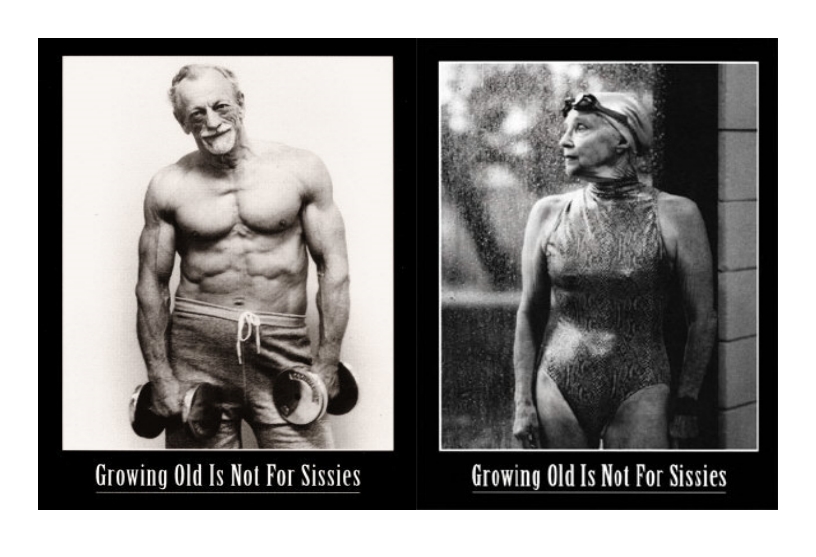
My guess is that vitamins C, E, and alpha lipoic acid, beta carotine, selenium, and other food based nutrients will help prevent or at least slow down the process. And of course, you could always exercise with weights, which is the best way to maintain muscle mass.
Muscle Loss Finding May One Day Save Physiques
ScienceDaily (Feb. 13, 2010) — Hey guys, remember the muscle shirts we wore in our teens and 20s? After the age of 40 that meager part of our wardrobes usually is obsolete. Yes, at the big 4-0 we begin to lose muscle, and by age 80 up to a third of it may be gone. It's an inevitable process of aging called sarcopenia.Why does sarcopenia happen and can it be stopped? A study conducted in mice with accelerated muscle loss at The University of Texas Health Science Center at San Antonio provides this insight: Less protection from antioxidants and more damage from oxidative stress results in impairment to cells' energy centers, which slowly leads to death of muscle cells.
A team directed by Holly Van Remmen, Ph.D., associate professor with the university's Barshop Institute for Longevity and Aging Studies and the Department of Cellular and Structural Biology, found that without a certain antioxidant enzyme to balance the formation of harmful reactive oxygen species (ROS), cellular energy centers called mitochondria fail to work properly. The mitochondria even add to the spate of ROS molecules and release factors leading to cell death.
"The impaired function of mitochondria also has a detrimental effect on the way motor neurons 'talk' to the muscle to achieve muscle contraction," Dr. Van Remmen said. "This interaction occurs at a specialized synapse where the nerve and muscle come in close contact." This key structure is called the neuromuscular junction, she said.
Smaller and weaker muscles
Youngmok C. Jang, Ph.D., a leading author in the study, investigated mice that were genetically engineered to lack an antioxidant enzyme called copper-zinc superoxide dismutase. He compared mitochondria from these mice and normal mice and found reduced function of the energy centers in the enzyme-deficient mice. This contributed to more cell death and muscle atrophy in the rodents. "As a result, their muscles were a lot smaller and weaker," Dr. Van Remmen said.
Insights gleaned about muscle loss can help scientists better understand other neuromuscular diseases such as amyotrophic lateral sclerosis (Lou Gehrig's disease). "Age-related muscle atrophy is a complex process and involves multiple systems," Dr. Van Remmen said. "There are, however, common mechanisms occurring in sarcopenia and other neuromuscular diseases. By understanding the mechanisms underlying age-related muscle atrophy and alterations at the neuromuscular junction, we should be able to gain insight that will help us to discover new therapeutic interventions."
If a muscle-preserving therapy is one day developed, future generations of young men will be able to keep their muscle shirts a bit longer.
A grant from the National Institute on Aging supported this project, along with a Julie Martin Mid-Career Award in Aging Research to Dr. Van Remmen from the American Federation for Aging Research.
Co-authors from the UT Health Science Center are Youngmok Jang, Ph.D.; Michael Lustgarten, Ph.D.; Yuhong Liu; Florian Muller, Ph.D.; Arunabh Bhattacharya, Ph.D.; Hanyu Liang, Ph.D.; Adam Salmon, Ph.D.; and Arlan Richardson, Ph.D. Other co-authors are Susan Brooks, Ph.D., and Lisa Larkin, Ph.D., of The University of Michigan and Christopher Hayworth, Ph.D., of The University of Texas at Austin. Drs. Van Remmen and Richardson have joint appointments with the South Texas Veterans Health Care System.
This paper was published online by The FASEB Journal on Dec. 29, 2009.
University of Texas Health Science Center at San Antonio (2010, February 13). Muscle loss finding may one day save physiques. ScienceDaily. Retrieved February 13, 2010, from http://www.sciencedaily.com /releases/2010/02/100212172533.htm
No comments:
Post a Comment